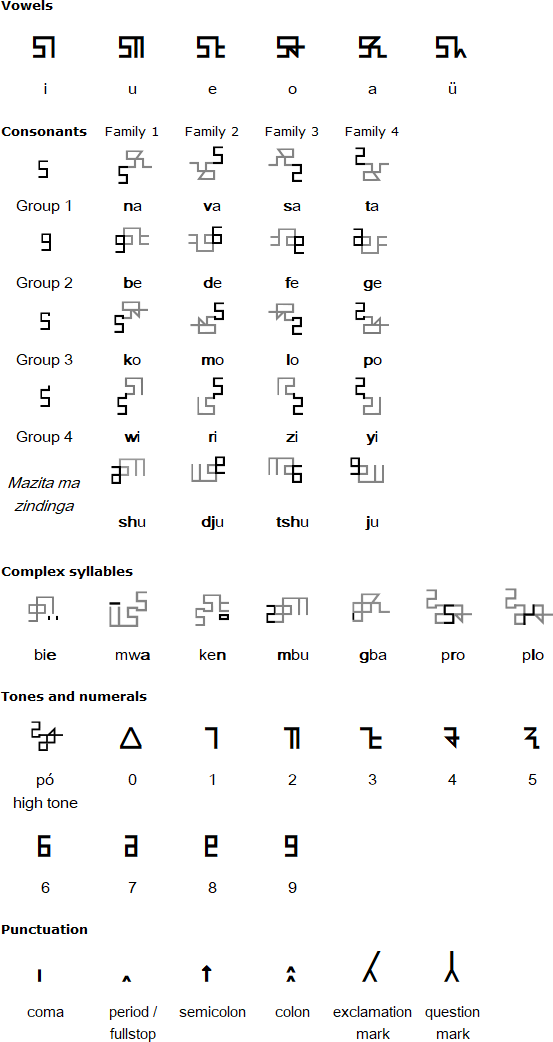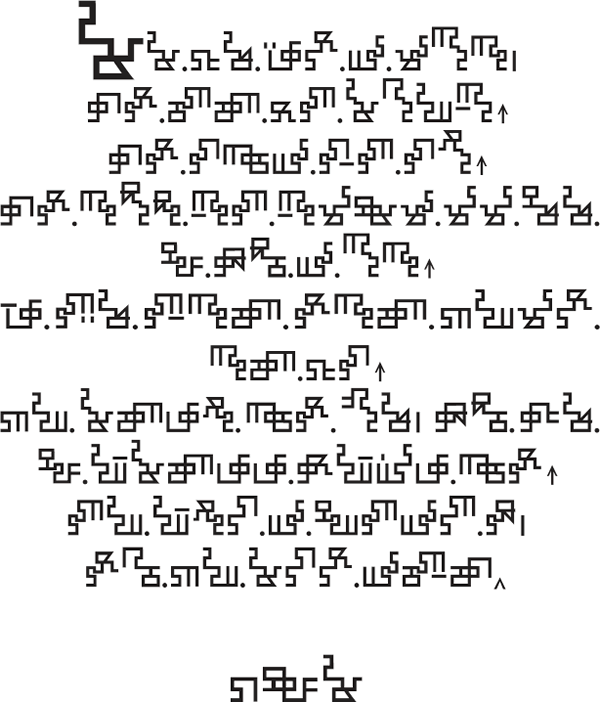The Mandombe alphabet was devised in 1978 by David Wabeladio Payi from the Democratic Republic of the Congo (DRC). It was apparently revealed in a dream to Simon Kimbangu, the prophet of the Kimbanguist Church. It is based on two shapes thought of as sacred that look like 5 and 2. It is intended to write the national languages of the Congo: Kikongo, Lingala, Tshiluba and Swahili.
Mandombe is taught is schools run by the Kimbanguist church in Angola, the Republic of the Congo, and the DRC. The Centre de l'Écriture Négro-Africaine (CENA), a Kimbanguist organisation, promotes the alphabet, and is developing ways to use it to write other Bantu languages.
Mandombe means "that which is black" in the Kikongo language. David Wabeladio Payi (1957-2013) was granted a patent for his script by the Ministry of Industry and Trade of the then Republic of Zaïre (now the DRC) in 1982. It was officially introduced to the public in 1994.

Download an alphabet chart for Mandombe (Excel)

Tata eto diena mu mazulu, bika nkumbu aku yazituswa; Bika kimfumu kiaku kiza; bika luzolo luaku luavangama vava ntoto mpe bonso mu zulu; Dia kweto kwalumbu kalumbu utuvana lumbu eki; Utu yambudila mfuka zeto, bonso beto mpe tuayambudidi batuavuidi mfuka; Kutu tualani mu mpukumunu ko, kansi utu tanina munkuambi. Ingeta
Source: http://www.hapax.qc.ca/pdf/notre-p%e8re-kikongo.pdf
Information about Mandombe
https://en.wikipedia.org/wiki/Mandombe_script
https://fr.wikipedia.org/wiki/Mandombe
http://www.afrikanistik-aegyptologie-online.de/archiv/2010/2724
http://www.bisharat.net/wikidoc/pmwiki.php/PanAfrLoc/Mandombe
https://www.facebook.com/Mandombe/
http://www.blackpast.org/gah/payi-david-wabeladio-1957-2013
https://kumatoo.com/wabeladio_payi.html
Mandombe font
https://fontstruct.com/fontstructions/show/1413148/mandombe-shingazidja-2
A-chik Tokbirim, Adinkra, ADLaM, Armenian, Avestan, Avoiuli, Bactrian, Bassa (Vah), Beitha Kukju, Beria (Zaghawa), Borama / Gadabuursi, Carian, Carpathian Basin Rovas, Chinuk pipa, Chisoi, Coorgi-Cox, Coptic, Cyrillic, Dalecarlian runes, Elbasan, Etruscan, Faliscan, Fox, Galik, Georgian (Asomtavruli), Georgian (Nuskhuri), Georgian (Mkhedruli), Glagolitic, Global Alphabet, Gothic, Greek, Hurûf-ı munfasıla, Irish (Uncial), Kaddare, Kayah Li, Khatt-i-Badíʼ, Khazarian Rovas, Koch, Korean, Latin, Lepontic, Luo Lakeside Script, Lycian, Lydian, Manchu, Mandaic, Mandombe, Marsiliana, Medefaidrin, Messapic, Mongolian, Mro, Mundari Bani, Nag Chiki, Naasioi Otomaung, N'Ko, North Picene, Novo Tupi, Nyiakeng Puachue Hmong, Odùduwà, Ogham, Old Church Slavonic, Oirat Clear Script, Ol Chiki (Ol Cemet' / Santali), Old Italic, Old Nubian, Old Permic, Ol Onal, Orkhon, Osage, Oscan, Osmanya (Somali), Pau Cin Hau, Phrygian, Pollard script, Runic, Székely-Hungarian Rovás (Hungarian Runes), South Picene, Sutton SignWriting, Sunuwar, Tai Viet, Tangsa, Todhri, Toto, Umbrian, (Old) Uyghur, Wancho, Yezidi, Zoulai
Page last modified: 15.03.23
[top]
You can support this site by Buying Me A Coffee, and if you like what you see on this page, you can use the buttons below to share it with people you know.

If you like this site and find it useful, you can support it by making a donation via PayPal or Patreon, or by contributing in other ways. Omniglot is how I make my living.
Note: all links on this site to Amazon.com, Amazon.co.uk
and Amazon.fr
are affiliate links. This means I earn a commission if you click on any of them and buy something. So by clicking on these links you can help to support this site.
[top]